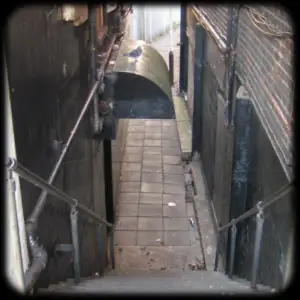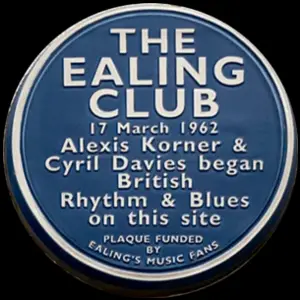THE EALING CLUB
 In 1959, The Ealing Jazz Club was a basement room opposite Ealing Broadway station, and it was reached by descending steep narrow stairs to an alley that leads out into a suburban street. On the left is a doorway that became a portal to the British R&B that re-invigorated the Blues and spread it to the world. Arthur (Art) Wood was a Blues fan from Ealing who sometimes sang with Alexis Korner and Cyril Davies in their band, later known as Blues Incorporated, and it is believed that in late 1961, Art suggested the Ealing Club as a possible venue for the music the guys were keen to play. Alexis and Cyril had been long-standing members of Chris Barber‘s band, where they mixed up a lot of Jazz and Blues, and the pair would play part of the set backing singer Ottilie Patterson as she belted out the Blues of Bessie Smith and Memphis Minnie. They had also backed Muddy Waters and Sister Rosetta Tharpe, as Chris invited top American Blues stars to tour with him, and this may have been the catalyst that inspired Alexis and Cyril to strike out and form their own band.
In 1959, The Ealing Jazz Club was a basement room opposite Ealing Broadway station, and it was reached by descending steep narrow stairs to an alley that leads out into a suburban street. On the left is a doorway that became a portal to the British R&B that re-invigorated the Blues and spread it to the world. Arthur (Art) Wood was a Blues fan from Ealing who sometimes sang with Alexis Korner and Cyril Davies in their band, later known as Blues Incorporated, and it is believed that in late 1961, Art suggested the Ealing Club as a possible venue for the music the guys were keen to play. Alexis and Cyril had been long-standing members of Chris Barber‘s band, where they mixed up a lot of Jazz and Blues, and the pair would play part of the set backing singer Ottilie Patterson as she belted out the Blues of Bessie Smith and Memphis Minnie. They had also backed Muddy Waters and Sister Rosetta Tharpe, as Chris invited top American Blues stars to tour with him, and this may have been the catalyst that inspired Alexis and Cyril to strike out and form their own band.
For several years, The Ealing Club played a central role in the London R&B scene, but it was soon copied by The Marquee, Kooks Kleek, the Eel Pie Club, the Crawdaddy, the Flamingo, the Ricky Tick and many more as dozens of new bands looked for places to play. Within months, there was a Blues Club in every city, and soon in every small town, as a circuit grew up that fuelled The British Blues Boom. The Ealing Club could only hold about 200 people, and by 1965 it was overtaken by bigger venues, so it closed its doors to R&B and re-opened as a casino, and later as a night-club. There have been a few rare live music events in the room, but many decades of near silence were broken recently when a group of local fans and musicians set up The Ealing Club, a Community Interest Company (not-for-profit organisation) to promote and perhaps re-open the club.

In 2011 they promoted six gigs, some at the old Ealing Club itself, to raise funds to install a proprietary Blue Plaque at the site, which was unveiled by Bobbie Korner (Alexis’s widow) on the 50th Anniversary of the original opening. The Ealing Club also arranged another Blue Plaque above the site of Jim Marshall‘s drum shop nearby, where Jim made the first of the amps that have carried his name to every major stage in the world, followed by a celebratory ‘Hootie’ which is now an annual event. They are deeply involved in the local film Festival, and promoting the local live music scene, not least with the Ealing Blues Festival every July, and gigs at the old Club have included a Tribute to Cyril Davies by some modern harp players. Blue Plaques are London’s way of commemorating sites of cultural importance, and it is hard to think of a place with more momentous global significance than The Ealing Club.
The University of Kansas Department of Musicology teaches a course on The Ealing Club as part of the story of British Blues, and the importance of what grew from those small beginnings is gradually becoming more widely recognised. The spark that caught fire in that basement room illuminated the world, and if there were to be a shrine to the re-birth of the Blues where the faithful come to pay homage, then the Temple should be at The Ealing Club.
Further information on The Ealing Club at http://www.ealing-club.com/